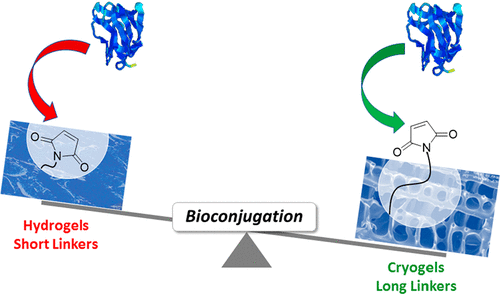当前位置:
X-MOL 学术
›
Bioconjugate Chem.
›
论文详情
Our official English website, www.x-mol.net, welcomes your feedback! (Note: you will need to create a separate account there.)
Thiol-Reactive Clickable Cryogels: Importance of Macroporosity and Linkers on Biomolecular Immobilization.
Bioconjugate Chemistry ( IF 4.7 ) Pub Date : 2020-07-28 , DOI: 10.1021/acs.bioconjchem.0c00318 Laura Chambre 1 , Hamida Maouati 1, 2 , Yavuz Oz 1 , Rana Sanyal 1, 2 , Amitav Sanyal 1, 2
Bioconjugate Chemistry ( IF 4.7 ) Pub Date : 2020-07-28 , DOI: 10.1021/acs.bioconjchem.0c00318 Laura Chambre 1 , Hamida Maouati 1, 2 , Yavuz Oz 1 , Rana Sanyal 1, 2 , Amitav Sanyal 1, 2
Affiliation

|
Macroporous cryogels that are amenable to facile functionalization are attractive platforms for biomolecular immobilization, a vital step for fabrication of scaffolds necessary for areas like tissue engineering and diagnostic sensing. In this work, thiol-reactive porous cryogels are obtained via photopolymerization of a furan-protected maleimide-containing poly(ethylene glycol) (PEG)-based methacrylate (PEGFuMaMA) monomer. A series of cryogels are prepared using varying amounts of the masked hydrophilic PEGFuMaMA monomer, along with poly(ethylene glycol) methyl ether methacrylate and poly(ethylene glycol) dimethacrylate, a hydrophilic monomer and cross-linker, respectively, in the presence of a photoinitiator. Subsequent activation to the thiol-reactive form of the furan-protected maleimide groups is performed through the retro Diels–Alder reaction. As a demonstration of direct protein immobilization, bovine serum albumin is immobilized onto the cryogels. Furthermore, ligand-directed immobilization of proteins is achieved by first attaching mannose– or biotin–thiol onto the maleimide-containing platforms, followed by ligand-directed immobilization of concanavalin A or streptavidin, respectively. Additionally, we demonstrate that the extent of immobilized proteins can be controlled by varying the amount of thiol-reactive maleimide groups present in the cryogel matrix. Compared to traditional hydrogels, cryogels demonstrate enhanced protein immobilization/detection. Additionally, it is concluded that utilization of a longer linker, distancing the thiol-reactive maleimide group from the gel scaffold, considerably increases protein immobilization. It can be envisioned that the facile fabrication, conjugation, and control over the extent of functionalization of these cryogels will make these materials desirable scaffolds for numerous biomedical applications.
中文翻译:

硫醇反应性可点击冰晶:大孔和连接分子对生物分子固定化的重要性。
易于功能化的大孔冷冻凝胶是用于生物分子固定的有吸引力的平台,这是制造组织工程和诊断传感等领域必需的支架的重要步骤。在这项工作中,通过对呋喃保护的含顺丁烯二酰亚胺的聚(乙二醇)(PEG)基甲基丙烯酸酯(PEGFuMaMA)单体进行光聚合,可以获得硫醇反应性多孔冰晶。在光引发剂的存在下,分别使用不同量的被掩蔽的亲水性PEGFuMaMA单体以及聚(乙二醇)甲基醚甲基丙烯酸酯和聚(乙二醇)二甲基丙烯酸酯,亲水性单体和交联剂,制备了一系列的凝胶。 。呋喃保护的马来酰亚胺基团随后被活化成硫醇反应性形式,这是通过逆Diels-Alder反应完成的。作为直接蛋白质固定化的证明,牛血清白蛋白被固定在冷冻凝胶上。此外,首先将甘露糖或生物素硫醇连接到含马来酰亚胺的平台上,然后分别进行伴刀豆蛋白A或链霉亲和素的配体定向固定,从而实现蛋白质的配体定向固定化。另外,我们证明了固定蛋白的程度可以通过改变冷冻凝胶基质中存在的硫醇反应性马来酰亚胺基团的数量来控制。与传统的水凝胶相比,冷冻凝胶显示出增强的蛋白质固定/检测能力。此外,可以得出结论,利用更长的链接器,使硫醇反应性马来酰亚胺基团与凝胶支架分开,可大大增加蛋白质固定化。可以设想,这些冷冻凝胶的容易制造,缀合和控制这些功能的程度将使这些材料成为许多生物医学应用的理想支架。
更新日期:2020-09-16
中文翻译:

硫醇反应性可点击冰晶:大孔和连接分子对生物分子固定化的重要性。
易于功能化的大孔冷冻凝胶是用于生物分子固定的有吸引力的平台,这是制造组织工程和诊断传感等领域必需的支架的重要步骤。在这项工作中,通过对呋喃保护的含顺丁烯二酰亚胺的聚(乙二醇)(PEG)基甲基丙烯酸酯(PEGFuMaMA)单体进行光聚合,可以获得硫醇反应性多孔冰晶。在光引发剂的存在下,分别使用不同量的被掩蔽的亲水性PEGFuMaMA单体以及聚(乙二醇)甲基醚甲基丙烯酸酯和聚(乙二醇)二甲基丙烯酸酯,亲水性单体和交联剂,制备了一系列的凝胶。 。呋喃保护的马来酰亚胺基团随后被活化成硫醇反应性形式,这是通过逆Diels-Alder反应完成的。作为直接蛋白质固定化的证明,牛血清白蛋白被固定在冷冻凝胶上。此外,首先将甘露糖或生物素硫醇连接到含马来酰亚胺的平台上,然后分别进行伴刀豆蛋白A或链霉亲和素的配体定向固定,从而实现蛋白质的配体定向固定化。另外,我们证明了固定蛋白的程度可以通过改变冷冻凝胶基质中存在的硫醇反应性马来酰亚胺基团的数量来控制。与传统的水凝胶相比,冷冻凝胶显示出增强的蛋白质固定/检测能力。此外,可以得出结论,利用更长的链接器,使硫醇反应性马来酰亚胺基团与凝胶支架分开,可大大增加蛋白质固定化。可以设想,这些冷冻凝胶的容易制造,缀合和控制这些功能的程度将使这些材料成为许多生物医学应用的理想支架。



























 京公网安备 11010802027423号
京公网安备 11010802027423号